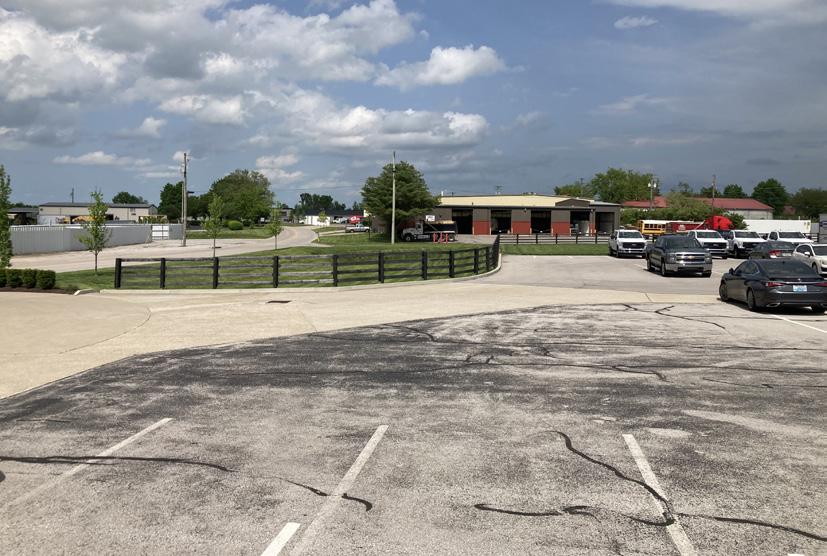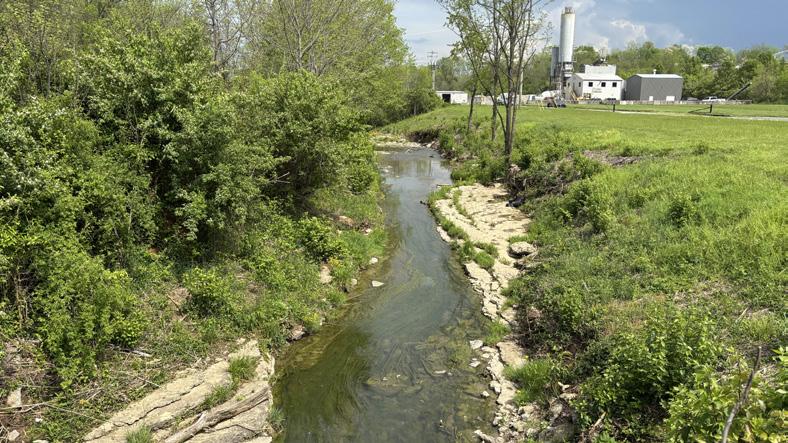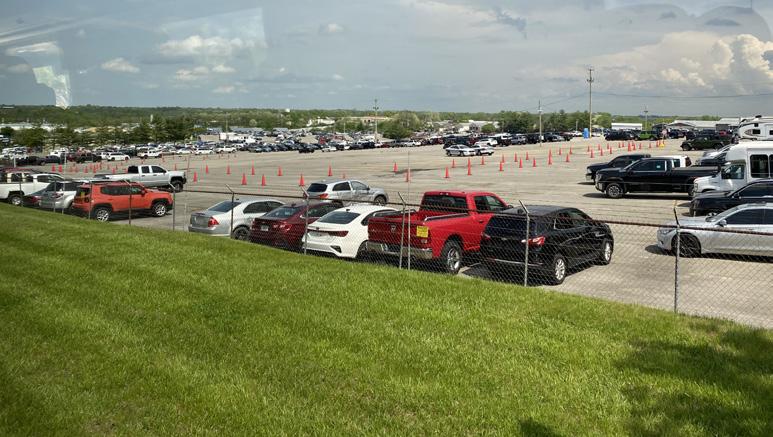






07.17.25 - Planning Commission Work Session









Transportation & Infrastructure Development Feasibility & Financing Mechanisms
Master Planning, Regulatory Approach, & Project Management


Site Selection Analysis Engagement, Branding, and Marketing Strategy

• Acreage brought in as part of the total 2,800+ acre UGMP
• Approximately 303.4 acres
• Experienced its most rapid growth and development in the late 1970s, early 1980s
• Anchored by several large companies and prominent property owners
• Neighbors include the hotel cluster at I-75, Sayre Athletics, and the new Lexington Sporting Club HQ

• Primarily industrial / heavy commercial with large expanses of impervious pavement
• Generally well landscaped, with many verdant areas
• Buildings tend to be low-rise warehousestyle structures, with pitched roofs and low loading dock heights
• Some small business park developments especially along United Court and Cutters Hill Court at the site’s north end




• Majority of study area is zoned I-1, supporting light industrial uses
• Small collection of properties zoned B-3 (Highway Service Business) facing Athens Boonesboro Road
• Bordered by A-R
• Edge of property touches B-5P (Interchange Service Business)


• Industrial properties mostly consist of manufacturing and warehouse functions, especially equipment storage
• Significant portion of industrial flex space, concentrated in a few facilities
• Retail and hospitality uses outside of the study area, towards I-75


• Approximately 60.4% of the Blue Sky Activity Center is impervious cover
• Asphalt/concrete takes up nearly 51.9% of all land
• Still relatively low for an industrial area


• Earliest phase of development began in the mid-1970s, during a notable expansion in Lexington’s manufacturing sector
• Primary development boom followed in the 1980s, with peak construction between 1986-1987
• Less than 10% of properties constructed after 2000
• Many buildings, coming to the end of their useful life, have been renovated


• Challenges with significant elevation change (+/- 130 vertical feet) from Athens
Boonesboro Road to stream at north end of study area
• Topography plateaus at edge of stream


• Portions of the site have steep (10%) and extremely steep (20%) slopes which transition between flat developed areas
• Smaller industrial buildings work well, but area can be challenging for larger single building development types without utilizing retaining walls


• Site is cut east / west by existing stream which has a 75’ stream buffer (150’ total width) and associated mapped floodplain.
• Existing property line roughly follows the stream bank, minimizing impacts to developable land
• Stream crossing needs to be improved to provide safe access to the rear of the site — no other roadway connections to rear of site are currently available


• Water — 12” loop main in Blue Sky Parkway, 8” mains serving rear
• Water — sufficient for typical industrial development except manufacturing
• Natural Gas — looped main in Blue Sky Parkway, some serving rear of site
• Natural Gas — mains should have sufficient capacity for typical industrial development except manufacturing


• Sewer — detailed sewer study under way of Blue Sky Pump Station and force main
• Sewer — availability for new connections but close to capacity and would require upgrades to stations
• Any development would be a swap of existing demand with proposed demand


• Crash rates at I-75 interchange signals are relatively high
• Also unexpectedly high number of crashes on Athens Boonesboro at unsignalized intersection between I-75 and Canebrake Drive
• Crashes within Blue Sky in the last 5 years are mostly within parking lots or with fixed objects / during the day


Concentration of industrial uses
throughout Study Area
Conducted survey of 103 buildings
Verified CoStar / Data axle market data
Created accurate point-in-time summary

Concentration of industrial uses
140 Businesses
1,000+ Jobs (estimate 2022)
Construction (300+)
Transportation / warehouse (160)
Manufacturing (138)

Jobs in Study Area by Monthly Earnings, 2022
$1,250 or less, 11% $1,251 to $3,333 , 27% More than $3,333 , 61%







Regional industrial business park
activity outside / within Lexington
Provides modern industrial / flex space with more amenities

Regional average growth (2045)
200,000 – 275,000 SF per year
4.2 to 5.8 million SF
Lexington capture 35% -40% (2045)
1.5 to 2.3 million SF
Blue Sky Study Area (2045)
200,000 to 400,000 SF


SITE LOCATION


STRATEGIC PLANNING
ECONOMIC DEVELOPMENT



CHUCK SEXTON CEO & FOUNDER
IVY STANLEY VICE PRESIDENT

CHANDRA WILLIAMS SENIOR CONSULTANT





Source: Area Development 2025 Annual Corporate and Site Selection Executive Survey


COMMUNITY & SITE VISIT/
ANALYSIS

COMMUNITY /DATA
ANALYSIS
DATA-DRIVEN DECISION MAKING

The Site Selection Process
Example Key Data Point: Historic and Projected Population Growth
– Population Comparison by Geography



Assesses Unemployment Rate, Labor Force Participation Rate, Population, Employed Population, Unemployed Population, and Hidden Population within a geography and compares to other geographies within the region against state and national data.









Assesses the number of people working and compares them to the number of people not working and thus dependent on someone else for their livelihood. For example, Kentucky’s EDR is 117.9, meaning for every 100 people working, there are 118 not in the workforce.



Lexington-Fayette County
• Ideally positioned in the center of one of North America’s major industrial corridors – the intersection of Interstates 64 and 75. Ninety percent of our clients will begin initial geographic searches along Interstates 75 and 65.


• Corporate site selection clients are also highly interested in communities with robust talent development pipelines, including secondary and post-secondary training, diversity of workforce training programs, availability of labor, and a strong quality of life to attract top talent.
Lexington-Fayette County would be considered a top contender in these key areas.

In agreement with Market Analysis conducted by PES for this project:
• Not positioned for significant employment growth but does support important mix of good-paying jobs for both Lexington-Fayette County and the regional economy.
• Vital industrial real estate for LexingtonFayette County that can be positioned for better planned reuse going forward.


• No feasible access to major transportation.
• Limited buildable area due to the presence of environmental factors without viable remediation plan.
• Costly mitigation factors like steep topography or unstable soil.
• Lack of suitable and scalable access to utility infrastructure.
• Land use restrictions and unclear ownership of site.
• Parcels that are too small, oddly shaped, or bisected in a way that prevents usable layout.
• Proximity to incompatible existing or planned future development like cemeteries, residential areas, public areas, and schools/school facilities that could create conflict or prevent permitting.
• Excessive ($) off-site infrastructure investment requirements.

1. Utility infrastructure limitations that could constrain future growth.
2. Minimal land available to create buffers between developments.
3. Limited land available to support existing industry expansion.
4. Private (K-12 school) sports facility located near Study Area boundaries.
5. Public-use sports facility adjacent to Study Area boundaries.
6. Existing and planned residential development in proximity to Study Area boundaries on and along Athens-Boonesboro Road.

1. Develop zoning specifically for the Study Area to support Lexington-Fayette County’s economic development goals.
2. Work with Commerce Lexington to develop and align infrastructure capacity expansion planning around the needs of targeted industry recruitment efforts.
3. Utilize an existing, or establish a new, industrial development authority to execute options on real estate within the Study Area when those opportunities arise; purchasing them when necessary to ensure desirable use over the long term.
4. Immediately begin marketing the former UPS facility for desired tenants.
5. Develop a close partnership with Elliott Services, a growing firm consuming properties within the Study Area to house growth and target complementary industries for infill and redevelopment opportunities.

Our Recommendations: Targeted Recruitment for Study Area
• Regional employer expansion
• Manufacturing
• Transportation and distribution
Key Drivers for Prospects:
• Location along interstate corridors.

• Affordable real estate that is available, prepared, and flexible to accommodate future growth (initial facility + room for future expansions).
• Population and workforce growth.
• Access to workforce training.


1. Prioritize developing publicly-owned industrial real estate. Industrial space should be a toppriority for planning, economic development, and elected officials.
2. Study successful communities of similar size and their land-use planning and growth practices, like Huntsville, Alabama.
Benchmark Lexington against Huntsville based on population, industry mix, and transportation access (major corridors of I-75 vs. I-65).
Lexington shines above the state of Kentucky, the US, and many competing regions, like Huntsville, however a lack of industrial real estate will continue to impact the community’s ability to recruit new industry to the area.
Huntsville was recently under consideration for a 1,000+ job manufacturing facility with average wages of $120,000 per year by our team due to many of the same advantages that Lexingon-Fayette County has with one exception: available industrial real estate.

Lexington-Fayette County – Future Development
Our Recommendations: LFCUG
Estimated Economic Impact of a Similar Project for Lexington-Fayette County and the MSA:
Direct Jobs Created: 1,000
Indirect and Induced Jobs Created: 762
TOTAL NEW JOBS: 1,762
Direct Total Impact:
$179.7 million in new payroll and $455.6 million in sales/output for the MSA


Indirect Total Impact:
$276 million in indirect and induced sales/output and compensation

3. Develop industry targets with jobs paying (on average) more than the MSA’s current average annual wage of $62,290 ($4,792/mo.).
Lexington-Fayette County’s share of the MSA’s total GRP ($39.7 Billion) is 72.6%. (2023)

Industrial Jobs:
In Lexington-Fayette County, Industrial Jobs, have 21.8% HIGHER average annual wages than Non-Industrial Jobs.
Industrial Jobs: $79,762
Non-Industrial Jobs: $65,474
Lexington-Fayette County is projected to LOSE 10% of it’s Industrial Jobs by 2034.



Over the last 10 years, Lexington-Fayette County LOST 10% of all Manufacturing Jobs, while the MSA GREW Manufacturing Jobs by 5%.
Lexington-Fayette County’s average Manufacturing wages GREW by 16.6% over the last 10 years (but are still 2.34% less than the MSA’s average Manufacturing wages).
Manufacturing in Lexington-Fayette County accounts for 7% of the community’s TOTAL GRP and 38.5% of the MSA’s total manufacturing-related GRP.



The Manufacturing industry in Lexington-Fayette County is the:
8th largest industry sector (by number of jobs)
6th highest paying industry sector (by average annual wage)
4th highest GRP-producing industry (2023)
Despite a projected net job loss (3%), Lexington-Fayette County’s Manufacturing industry has a total talent demand of 10,875 people over the next 10 years.



Over the last 10 years, the number of jobs in Transportation and Warehousing in Lexington-Fayette County GREW by 19%, but those jobs have an average annual wage that is 35% LESS than Manufacturing.
Transportation and Warehousing in Lexington-Fayette County accounts for 3.2% of the community’s TOTAL GRP and 71.3% of the MSA’s total transportation-related GRP.



The Transportation and Warehousing industry in Lexington-Fayette County is the:
9th largest industry sector (by number of jobs)
16th highest paying industry sector (by average annual wage)
11th highest GRP-producing industry (2023)
Lexington-Fayette County’s Transportation and Warehousing industry has a total talent demand of 11,805 people over the next 10 years.



Based on initial data analysis conducted by PES and SLA, LexingtonFayette County is a prime location for continued growth. The healthy labor force participation rate indicates a population with a desire to work.
Growth will be dependent upon LFUCG’s ability to plan and execute implementation of recommendations specifically around industrial, commercial, and residential land-use planning.
Industrial Jobs are critical to the local and regional economy.
Industrial space should be a top-priority for planning, economic development, and elected officials.